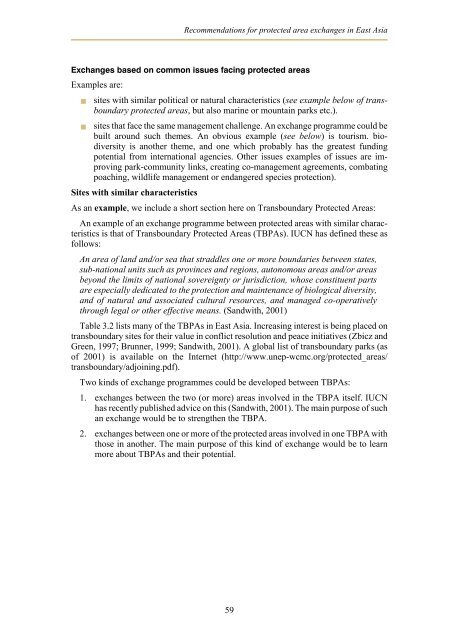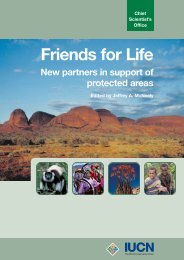Exchange programmes - IUCN
Exchange programmes - IUCN
Exchange programmes - IUCN
You also want an ePaper? Increase the reach of your titles
YUMPU automatically turns print PDFs into web optimized ePapers that Google loves.
<strong>Exchange</strong>s based on common issues facing protected areas<br />
Examples are:<br />
Recommendations for protected area exchanges in East Asia<br />
� sites with similar political or natural characteristics (see example below of transboundary<br />
protected areas, but also marine or mountain parks etc.).<br />
� sites that face the same management challenge. An exchange programme could be<br />
built around such themes. An obvious example (see below) is tourism. biodiversity<br />
is another theme, and one which probably has the greatest funding<br />
potential from international agencies. Other issues examples of issues are improving<br />
park-community links, creating co-management agreements, combating<br />
poaching, wildlife management or endangered species protection).<br />
Sites with similar characteristics<br />
As an example, we include a short section here on Transboundary Protected Areas:<br />
An example of an exchange programme between protected areas with similar characteristics<br />
is that of Transboundary Protected Areas (TBPAs). <strong>IUCN</strong> has defined these as<br />
follows:<br />
An area of land and/or sea that straddles one or more boundaries between states,<br />
sub-national units such as provinces and regions, autonomous areas and/or areas<br />
beyond the limits of national sovereignty or jurisdiction, whose constituent parts<br />
are especially dedicated to the protection and maintenance of biological diversity,<br />
and of natural and associated cultural resources, and managed co-operatively<br />
through legal or other effective means. (Sandwith, 2001)<br />
Table 3.2 lists many of the TBPAs in East Asia. Increasing interest is being placed on<br />
transboundary sites for their value in conflict resolution and peace initiatives (Zbicz and<br />
Green, 1997; Brunner, 1999; Sandwith, 2001). A global list of transboundary parks (as<br />
of 2001) is available on the Internet (http://www.unep-wcmc.org/protected_areas/<br />
transboundary/adjoining.pdf).<br />
Two kinds of exchange <strong>programmes</strong> could be developed between TBPAs:<br />
1. exchanges between the two (or more) areas involved in the TBPA itself. <strong>IUCN</strong><br />
has recently published advice on this (Sandwith, 2001). The main purpose of such<br />
an exchange would be to strengthen the TBPA.<br />
2. exchanges between one or more of the protected areas involved in one TBPA with<br />
those in another. The main purpose of this kind of exchange would be to learn<br />
more about TBPAs and their potential.<br />
59






